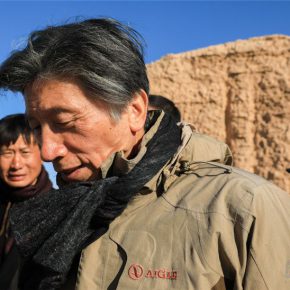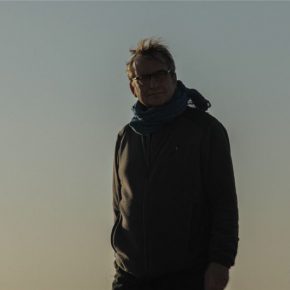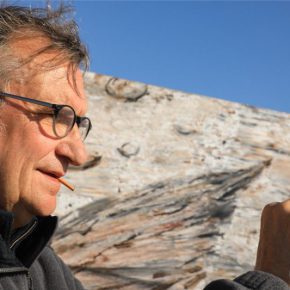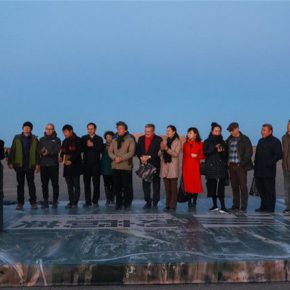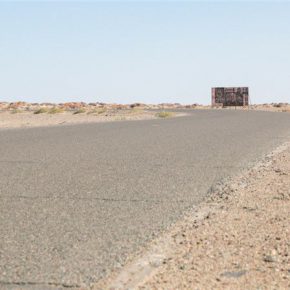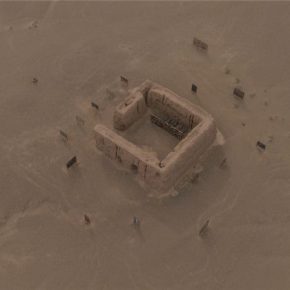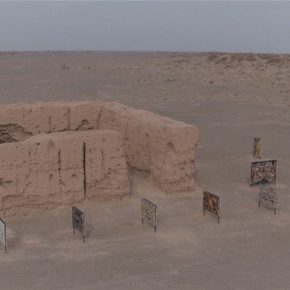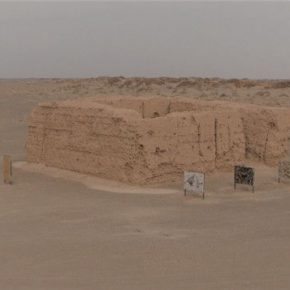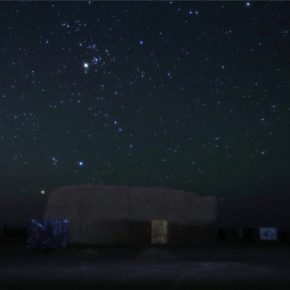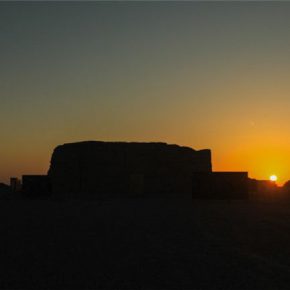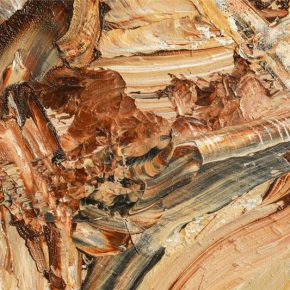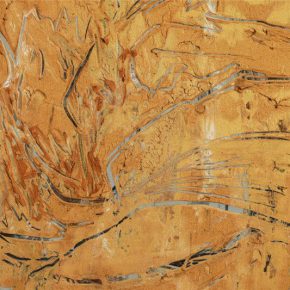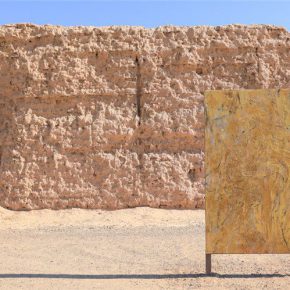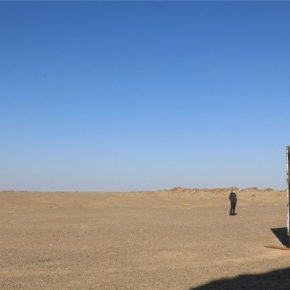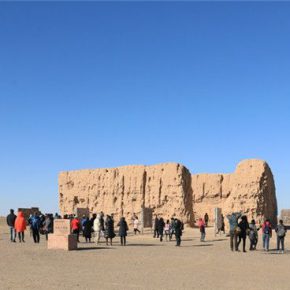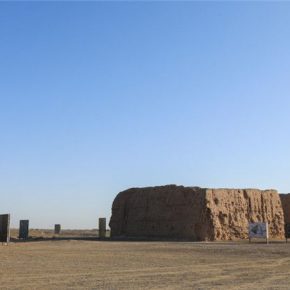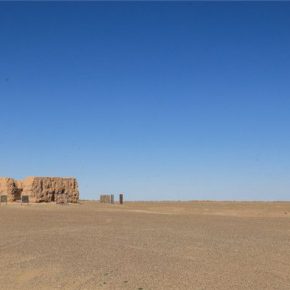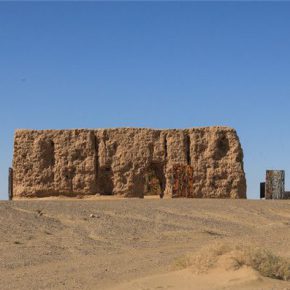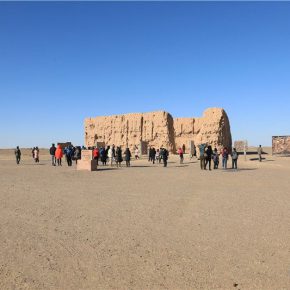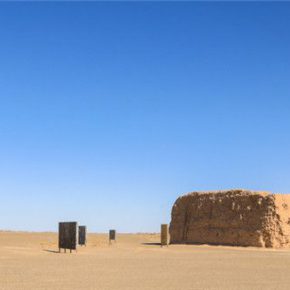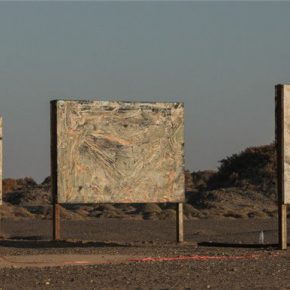
“This mysterious road leads to the heart, in which there is an eternal world—the past and the future.” —Novalis
In order to visit Ejin Banner?in Inner Mongolia, I went to Yinchuan from Beijing by air?and then took another small plane across the mountains and desert, then I?caught several buses to arrive at my destination. An alternative route would have been to drive though I would have had to travel?day and night through the continuous Gobi desert and depopulated zone, no matter which path?you choose to take, it is a great challenge for a novice traveler. However, the artist Liu Shangying has repeatedly penetrated this vast desert, for three consecutive ?years, staying alone in this lonely place where it is full of sand, in order to sketch large-scale paintings. On October 21, 2017, Liu Shangying held a solo exhibition of “Living Natures?– Liu Shangying” at the ruins of the red town, an ancient pass from the Han Dynasty, in the Ejin Banner, featuring 31 large-scale oil paintings themed on the dead but immortal populus diversifolias that he had studied in the Ejin Banner?over the three years. After experiencing an unexpected fire which almost destroyed all his works, this unprecedented field exhibition offered a “rebirth from the ashes” for the artist himself.
As early as 2011, Liu Shangying began traveling to Ali in Tibet to sketch. As it is a fair distance from the city, the inertia and trivial things are reduced, there is an opportunity to enter prehistoric nature in order to be “closer to the self”. He enjoys being guided by an indescribable, unknown mysterious force.
A Panoramic Nature: An Experimental Exploration as an Exhibition
The choice of venue is the part most worthy of exploration. When the unprecedented exhibition was unveiled, it gave the audience unusually strong and complex feelings, which was beyond “magnificence”. Located in Northern China, Ejin Banner?is an untraversed region, with the ancient name of “Juyan”, an important stop on the ancient Silk Road. It was called the “ancestral land” in Torghut?Mongolian, which was often regarded as the earliest capital of the Northern Huns, with a land area that is composed of 110,000 square kilometers, and only 30,000 residents, the major part of the territory is covered by uninhabited deserts.
As the artist who first uses an isolated exotic scene as the site of exhibition, Liu Shangying presents the show in the 2000 year-old ruins of the red town of Han Dynasty.?For 15 days, he uses creations to form a 24-hour non-stop display space field. This unrestrained idea came from an?occasional?experience of Liu Shangying?when he took?a photo of the painting,?as?the finished works were placed in front of the alienated?and broken walls in the desert, the energy generated by the instant intersection of history, reality, nature and civilization greatly stimulated the artist’s imagination and determination—“l(fā)ike growing together.”
It seems to swallow the people coming from afar up. The artist offers the audience who is present at the exhibition a passionate and distorted experience of the creation scene, “the traces of the strokes seem to have an isomorphic relationship with the flowing earth of Ejin Banner.” The self, canvas and pigments are like the dust in the universe. They are born into nature and eventually return to nature.
This unique and independent outdoor field, the “man” that occasionally appears is not the most important observer. The watching and reading of the heaven & earth, sun & moon, and stars through the night to dawn, the raging & entanglements of the wind & sand and frost, together with the work constitute the most important interactive relationships. Liu Shangying expressed his understanding of the “Living Natures” through the paintings and exhibition, abandoning the exhibition space of traditional art museums to bring an exploration of nature, bearing in mind that the challenge of the works may be destroyed at any time, devoutly offering his works to heaven and earth, to complete a real dialogue with nature. From this perspective, regardless of the starting point and the point of completion in?painting, the artist Liu Shangying is an artist who is extremely pure and idealist. Although it is a very challenging job, Liu Shangying and his team still overcame the difficulties to finish the exhibition.
From Looking at the Sky to Overlooking the Earth: the Creative Context in Recent Years ??
In the past three years, Liu Shangying has held a solo show every year, including “Myriad Vision Rise from the World” held at the National Art Museum of China in 2015, “A Blue Mountain Looms into the Town” held in Changshu Art Museum in 2016, and “Living Natures—Liu Shangying” held at the ruins of the red town in the Ejin Banner?in 2017. Prof. Ma Lu said that, “Shangying’s paintings have always had a strong clue to ‘life’.”
Some of the paintings?themed on Tibet are considered as “the relatively?classic traditional sketch” by the scholars, although these works show an abstract expressionism style, we can still recognize vaguely specific objects such as the skyline, mountains, lakes and the blue sky. When Liu first faced the vast prehistoric place, he felt that paintings were totally dumbfounded. Going deep into the area, he had to abandon the experiences of traditional painting, he failed to rigidly adhere to the form of painting language and?an elegant style, and engaged in the practice of “simple labor”, while the calm process made him “felt at ease.”?It was the beginning of his dialogue with?nature which also became a turning point in his painting career.
Changshu series reflects an episode which is similar to a “healing” in the artist’s creation. In the spring of 2016, Liu Shangying?was invited by Wu Wenxiong, Director of the Changshu Art Museum, to visit Changshu in the regions south of the Yangtze River to sketch. During this creation, all?his paintings stored in his studio were destroyed by a fire which was caused by a circuit failure during a thunderstorm, including all the works finished in Tibet, the sketches in Ejin Banner, Inner Mongolia, as well as the works finished in Changshu. As a witness to the fire, he?experienced the tragedy and shock, losing all the creations of painstaking efforts. After a period of depression, he finally recovered and started drawing again. Although there are only the refined landscapes?of the regions south of the Yangtze River, Liu Shangying’s creations in Changshu were blended with his own perception of geographical history, culture and life, showing a deep & profound?emphasis for the regions south of the Yangtze River which is hidden from the public view.
While?his?works on?Ali in Tibet look up at the sky, his works on?Ejin Banner?in Inner Mongolia overlook the earth. Curator Olivier Kaeppelin talked about the three dimensions of Liu Shangying’s paintings. Firstly, he was influenced by traditional Chinese painting, poetry and philosophy, the ideal of ancient Chinese theory that man was an integral part of nature, the minutiae of people in the nature of the universe; secondly, it was similar to the experiments of action painting, which was different from the Impressionist outdoor painting?that was?in pursuit of the light and image itself,?the?action of painting emphasized the expansion of the involvement of the body in the expression of painting. The experience of watching, the experience of action, and the natural changes involved in the process of the painting were more important than the traces that remained on the screen; thirdly, the interweaving of the art and nature, “art creation belongs to its own nature, namely the ‘second nature’ that possesses?an independent territory, space and laws”, and the field of life created by the painting or sculptural actions, was Liu Shangying’s core for this exhibition.
A Mysterious Road Leads?to the Heart: Liu Shangying’s View of Painting
As the oldest and most difficult art style in contemporary art, the development and possibilities of painting are the common problems faced by the global cultural context in the digital age.Liu Shangying’s thought on painting and the exploration of his creative style both have?a significance for a breakthrough in individual practice, and an effective response to the problem of contemporary painting.
Within an original chaotic ecology, Liu Shangying found a new creative method for landscape painting. He stressed on being “at the scene” rather than “painting the scene”. Whether he was in a plateau or a desert, overcoming the great physical difficulties?to be on-site to create large-scale paintings, in order for the paintings to perceive and enter nature, and then move towards the heart, searching for the self, rather than describing the landscape itself.
Olivier Kaeppelin questioned himself and the artist about “nature and art, which is more viable?” Olivier Kaeppelin believes that works of art are a projection of nature in the mind of a human, allowing “death” to be seen as eternal life, so that art has a longer life than the nature. Liu Shangying believes that the vitality of art lies on a spiritual level, with inspiration for the future; while natural vitality has always been at the same place with the same form. They are mysterious and holy, quietly living hidden in the objective phenomenon, coming alive over and over again.
German philosopher Friedrich Schelling saw both the “spirit of the world” in nature and the mind of people, while nature and the spirit are actually the appearance of the same thing. Therefore, the romantic poet Novalis revealed the secret stating that: “A mysterious road leads to the heart”. It means that the whole of nature exists in the hearts of people, if one can enter his own heart, he will be close to the mystery of the world.
Text by Zhu Li, translated by Chen Peihua and edited by Sue/CAFA ART INFO
Photo by Wu Songbo?


